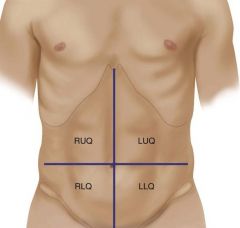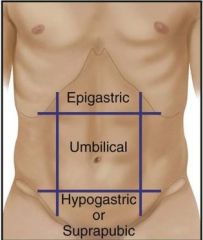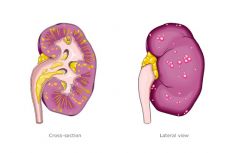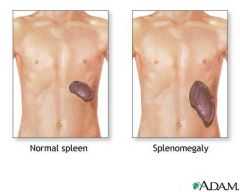NURS 307 Abdomen/ Nutrition Assessment Flashcards
NURS 307 Abdomen/ Nutrition Assessment Flashcards
|
Identify the 2 types of viscera in the abdomen. Which of these percuss tympany? |
Solid viscera |
|
|
Identify the quadrants in the abdomen. |
RUQ |
|
|
Identify and describe the 3 regions of the abdomen. |
Epigastric – above belly button Umbilicus – around belly button area Hypogastric/Suprapubic – below belly button, above pubic region |
|
|
Identify the nationalities that have increased risk for lactose intolerance at birth. |
African Americans, Native Americans, Asians, and Mediterranean groups ORDER NURS 307 NOW |
|
|
abdomen |
large oval cavity extending from diaphragm down to the brim of the pelvis |
|
|
Identify what organs/structures are in the RUQ. |
liver, gallbladder, duodenum, head of pancreas, R kidney and adrenal, hepatic, flexure of colon, part of ascending and transverse colon |
|
|
Identify what organs/structures are in the LUQ |
stomach, spleen, L lobe of liver, body of pancreas, L kidney and adrenal, splenic flexure of colon, part of transverse and descending colon |
|
|
Identify what organs/structures are in the LLQ. |
part of descending colon, sigmoid, colon, L ovary and tube, L ureter, L spermatic cord |
|
|
Identify what organs/structures are in the RLQ. |
cecum, appendix, R ovary and tube, R ureter, R spermatic cord |
|
|
Identify the common chief complaint for abdomen. |
Abdominal pain, unspecific |
|
Identify the normal range in frequency for bowel movements. |
o Frequent 2-3 times per day |
|
|
Should feces be floating or sinking? |
It should be sinking. If it’s floating, it means patient is not getting enough fiber. |
|
|
If a patient is vomiting/having diarrhea more than ______ times a day, you will be concerned about dehydration. |
five |
|
|
Why must you auscultate before palpation and percussion? |
If you percuss or palpate first, you will create gurgles/sounds in the abdomen. |
|
|
Identify the 4 descriptions of bowel sounds. |
Normal (normoactive) |
|
|
What does it mean when you hear a bruit when checking for vascular sounds? |
It could mean there is an aneurysm. |
|
|
Identify the 2 types of sound you would hear via percussion. |
Tympany and dullness |
|
|
pyelonephritis |
Inflammation of the kidney and its pelvis, caused by bacterial infection. |
|
|
organomegaly |
abnormal enlargement of organs Pic: Spleen enlargement |
|
|
Describe the two types of palpation. |
Light – 1 cm Deep – 2-3 inches |
|
ascites
|
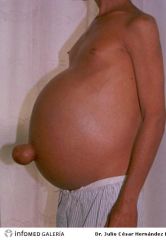 accumulation of serous fluid in the peritoneal cavity
|
|
|
constipation
|
bowels are evacuated at long intervals or with difficulty/straining,
stool is usually very hard
|
|
|
umbilical hernia
|
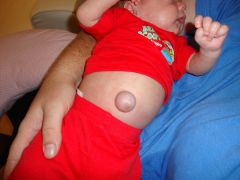 soft skin covered mass which is the protrusion of the intestine
through a weakness or incomplete closure in the umbilical ring
Note: When person is relaxed, you should be able to retract this into belly. |
|
|
hepatitis
|
inflammation and usually enlarged liver
|
|
|
gastroesophageal reflux (GER/GERD)
|
complex of symptoms of
esophagitis, heartburn, usually occurs 30-60 minutes after eating, aggravated by lying down or bending over, (in infants characterized by spitting up/vomiting)
|
|
|
aortic aneurysm
|
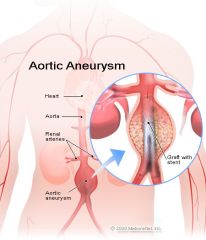 pulsating mass in the upper abdomen just left of midline; positive bruit, decreased femoral pulses
Note: 80% are palpable during routine physical exam |
|
|
Describe pain related to appendicitis.
|
diffuse pain in periumbilical region that later shifts to severe, sharp, persistent pain and tenderness localized in RLQ (McBurney’s point)
|
|
|
Appendicitis pain is aggravated by _________. (2)
It is associated with the following symptoms: __________. (3) |
aggravated by movement, coughing
anorexia, N/V, fever |
|
|
gastroenteritis/gastritis (AGE)
|
diffused generalized abdominal pain with nausea and diarrhea
|
|
|
cholecystitis
|
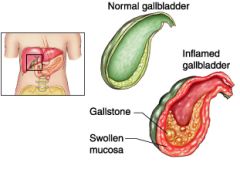 inflammation of the gallbladder
|
|
Describe the clinical manifestation of cholecystitis and its causes.
|
Sudden pain in RUQ that may radiate to right or left scapula and which builds over time, lasting 2-4 hours after ingestion of fatty foods, alcohol, or caffeine
|
|
|
Cholecystitis is common in ______.
|
females > 40 years old.
|
|
|
A bruit indicates _________ in _________ vessels.
|
turbulent blood flow
in constricted, abnormally dilated, or tortuous vessels |
|
|
What result confirms rebound tenderness (Blumberg sign)?
|
Pain on release of pressure
|
|
|
Describe how to perform the following test: rebound tenderness. What is normal response?
|
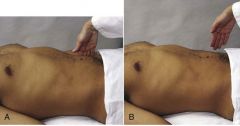 Choose a site away from the painful area. Hold your hand 90 degrees, or perpendicular, to the abdomen. Push down slowly and deeply; then lift up quickly.
A normal, or negative, response is no pain on release of pressure. |
|
|
Describe how to perform the following test: inspiratory arrest (Murphy Sign). What is a normal response?
|
Hold your fingers under the liver border. Ask the person to take a deep breath.
A normal response is to complete the deep breath without pain. |
|
|
Describe how to perform the following test: iliopsoas muscle test.
|
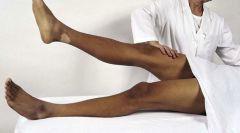 With the person supine, lift the right leg straight up, flexing at the hip (Fig. 21-31); then push down over the lower part of the right thigh as the person tries to hold the leg up.
|
|
|
Identify the 5 locations you would listen for vascular sounds.
|
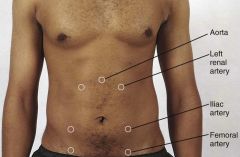 Aorta
L/R renal artery L/R iliac artery L/R femoral artery |
|
|
hepatomegaly
|
enlarged liver
|
|
|
Hypoactive or absent bowel sounds typically follow ___________. (2)
|
abdominal surgery or inflammation of the peritoneum
|
ORDER NURS 307 Abdomen/ Nutrition Assessment Flashcards
|
peritoneum
|
serous membrane lining the cavity of the abdomen and covering the abdominal organs
|
|
|
An individual is 5′ 3” in height and weighs 120 pounds. What is their BMI?
|
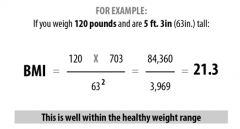 21.3
|
|
|
apple shape vs. pear shape
|
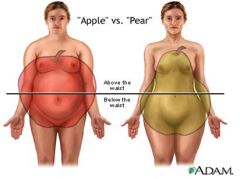 Apple – Wider waist than hips
Pear – Wider hips than waist |
|
|
Which of the following has a higher risk for heart disease: apple shape or pear shape?
|
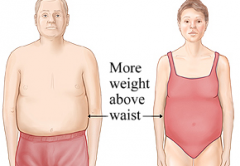 Apple shape
|
|
|
Describe how to calculate waist/hip ratio.
|
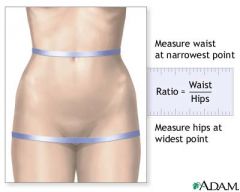 Ratio = Waist/Hips
|
|
|
Identify the formula for BMI using inches and pounds.
|
 |
|
|
Perform the iliopsoas muscle test when ________ is suspected.
|
appendicitis
|
|
|
What is the normal result for iliopsoas muscle test?
|
No pain/change
|
|
|
When the iliopsoas muscle is inflamed (which occurs with an inflamed or perforated appendix), pain is felt the ______ quadrant.
|
RLQ
|
|
|
TRUE/FALSE
Evidence shows that the Obturator Test, another technique that stretches the obturator muscle, does not work to diagnose appendicitis. |
True
|
|
Sharp pain during CVA tenderness test indicates __________.
|
Sharp pain occurs with inflammation of the kidney or paranephric area.
|
|
|
Describe how to perform the following test: CVA tenderness. What is normal response?
|
To assess the kidney, place one hand over the twelfth rib at the costovertebral angle on the back (Fig. 21-17). Thump that hand with the ulnar edge of your other fist.
Normal response is no pain. |
|
|
Identify the disease/condition the following patient may have.
You feel a pulsating mass in the upper abdomen. You hear a bruit in that region and the pt has decreased femoral pulses. |
Aortic aneurysm
|
|
|
Identify the disease/condition the following patient may have.
Pt has had increasing pain in the RLQ. The pain started in the preumbilical region and has gotten worse and moved to the RLQ. |
Appendicitis
|
|
|
Identify the disease/condition the following patient may have.
Pt has abdominal pain throughout belly. He/She is also experiencing nausea and diarrhea. |
Gastroenteritis/gastritis
|
|
|
Identify the disease/condition the following patient may have.
Pt reports pain lasting ~3 hours after ingesting fatty foods and caffeine. The pain is in the RUQ. |
Cholecystitis
|
|
|
Identify the disease/condition the following patient may have.
Pt feels heartburn ~30 minutes after eating. He said it feels worst after lying down or bending over. |
gastroesophageal reflux (GER/GERD)
|
|
|
Blumberg sign = _______ test
|
rebound tenderness
|
|
|
Murphy sign = _______ test
|
inspiratory arrest
|
